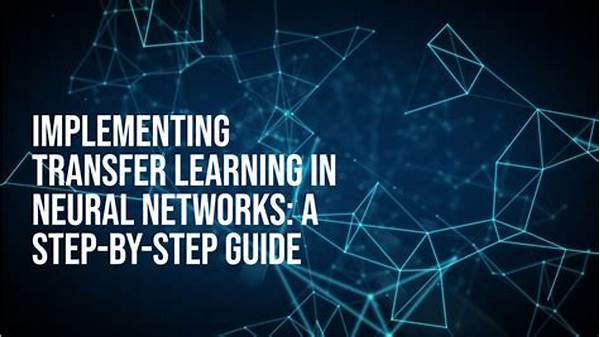Transfer Learning in Neural Networks: A Paradigm Shift in AI
The world of artificial intelligence is ever-evolving, with new techniques and methodologies being developed at a breakneck pace. Among these innovations, transfer learning in neural networks stands out as a beacon of efficiency and ingenuity. This revolutionary approach allows models to apply knowledge learned from one task to another related task, greatly enhancing their performance while reducing time and resources spent on training. The goal of transfer learning is not merely to train a model but to enable it to find connections, adapt, and excel beyond its original programming. It’s this adaptability that makes transfer learning a game-changer in neural network applications, providing vast opportunities to tackle complex problems in a fraction of the time.
The ability of neural networks to learn and generalize is incredible, yet training them from scratch can be both time-consuming and expensive. Transfer learning offers a solution by leveraging pre-trained models as a starting point for new tasks. Imagine you’ve spent years learning to ride a bicycle; applying this balance and coordination experience to learning how to ride a motorcycle saves considerable time and effort. Similarly, transfer learning in neural networks accelerates machine learning by allowing previously acquired knowledge to enhance new task performance. Consequently, it has taken center stage in the AI realm, catching the attention of businesses, researchers, and innovators eager to optimize their artificial intelligence strategies.
For those who find the technicalities behind AI development somewhat daunting, the principles of transfer learning make the technology more accessible. By enabling models to apply past learnings to new challenges, transfer learning in neural networks opens doors to creativity and exploration. Companies can cut through the complexities of data processing and focus on deploying novel applications across industries as diverse as healthcare, software development, and marketing. The sheer versatility and practicality of this approach are testament to its growing popularity and success.
Notably, the impact of transfer learning extends beyond corporate walls and academic institutions. Everyday users benefit too, often unknowingly, as transfer learning powers many of the intuitive applications and devices that we interact with daily. From mobile apps that anticipate our needs to improved customer service chatbots that learn from previous interactions—transfer learning in neural networks is omnipresent, silently revolutionizing how we experience technology.
Enhancing AI Through Transfer Learning
Transfer learning in neural networks is no longer a futuristic concept but a present-day reality driving the transformation of machine learning applications. Its widespread adoption illustrates its crucial role in shaping a smarter, more efficient world. With ongoing research and experimentation, the boundaries of what transfer learning can achieve are continuously expanding, promising groundbreaking advancements for years to come.
—Understanding Transfer Learning in Neural Networks: The Basics
Transfer learning in neural networks is a term you might have seen floating around the tech world, but what does it really entail? At its core, transfer learning is about taking a model that has been pre-trained on one task and fine-tuning it for another. This method not only saves time but also leverages previously gathered knowledge to enhance performance in new domains. It’s akin to moving to a new city and using your past experiences to quickly learn how to navigate, find social circles, and adapt to cultural nuances.
A compelling aspect of transfer learning in neural networks is how it simplifies the training process. Traditional models require massive amounts of data to understand intricate patterns, but transfer learning reduces this demand. Historical data and trends from existing large datasets act as a springboard, taking your model from crawling to sprinting in record time.
In the buzzing ecosystem of technology, companies are continually finding fresh ways to capitalize on transfer learning. By reducing the dependence on large volumes of labeled data, businesses can launch AI products faster, gaining a competitive edge. Additionally, resource-constrained sectors can now join the fast lane of innovation without monumental investments in data acquisition and processing.
How Transfer Learning Redefines AI Possibilities
As the field of AI grows, so does the potential of transfer learning in neural networks to resolve complex issues efficiently. One notable example is in medical diagnostics, where pre-trained models can differentiate between healthy and diseased states quicker and with greater accuracy. What was once thought impossible or too resource-intensive now becomes a viable reality, thanks to this strategic application of transfer learning.
The benefits extend beyond improved efficiency; they also include democratizing access to AI technologies. Through transfer learning, even budding developers can harness the power of advanced neural networks without requiring vast computational resources or in-depth expertise. This not only fosters inclusivity in tech but empowers a diversity of thought and innovation.
Exploring the Impact of Transfer Learning
The implications of transfer learning in neural networks are vast, promising a future where AI applications are more responsive, effective, and readily available. Whether it’s as mundane as a recommendation engine in your favorite app or as critical as a diagnostic tool in healthcare, transfer learning is the invisible force shaping the next frontier of innovation.
—Examples of Transfer Learning in Action
Leveraging Transfer Learning for AI Success
Understanding transfer learning in neural networks is pivotal for businesses and developers looking to innovate with fewer obstacles. It embodies an efficient learning pathway that not only speeds up AI development but also reduces costs considerably. As AI continues to permeate every aspect of our lives, the role of transfer learning becomes even more pronounced, acting as the catalyst for smart, adaptive, and intuitive technology solutions that cater to tomorrow’s needs.
Transfer learning in neural networks is not just the future of AI; it’s the now. The potential is boundless, and the opportunity is ripe for those ready to harness its power to propel their innovation journey. Embrace the change, stay ahead of the curve, and witness the marvels of what transfer learning can accomplish in revolutionizing the AI landscape.

